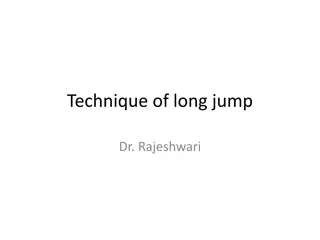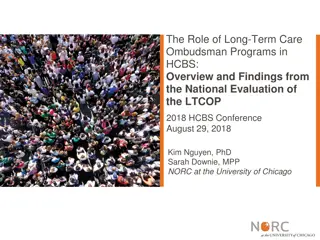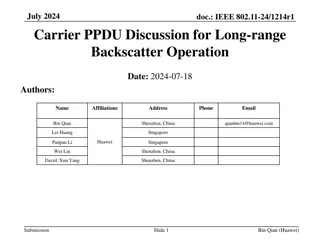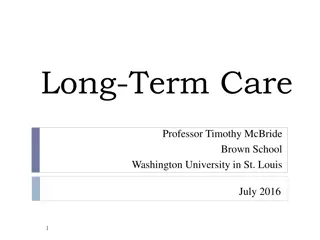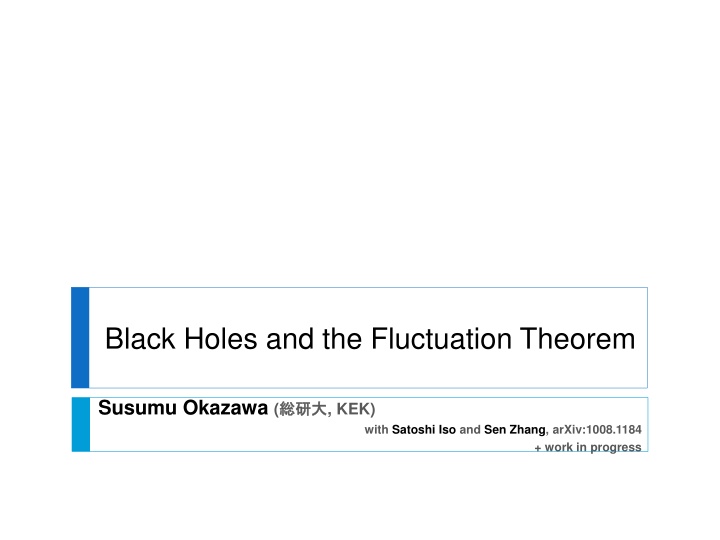
Exploring Black Holes and Fluctuation Theorem for Non-Equilibrium Systems
Delve into the intriguing world of black holes and the fluctuation theorem as researchers investigate the non-equilibrium nature of these celestial bodies. Gain insights into black hole thermodynamics, Hawking radiation, and classical gravity in the quest to understand the information loss problem and refine the Einstein Equation of State, with potential applications in gauge/gravity duality.
Download Presentation

Please find below an Image/Link to download the presentation.
The content on the website is provided AS IS for your information and personal use only. It may not be sold, licensed, or shared on other websites without obtaining consent from the author. If you encounter any issues during the download, it is possible that the publisher has removed the file from their server.
You are allowed to download the files provided on this website for personal or commercial use, subject to the condition that they are used lawfully. All files are the property of their respective owners.
The content on the website is provided AS IS for your information and personal use only. It may not be sold, licensed, or shared on other websites without obtaining consent from the author.
E N D
Presentation Transcript
Black Holes and the Fluctuation Theorem Susumu Okazawa ( , KEK) with Satoshi Iso and Sen Zhang, arXiv:1008.1184 + work in progress
1. Introduction [1/3] Backgrounds Black hole thermodynamics Hawking radiation classical gravity + quantum field Planck distribution with temperature Motivations We want to investigate non-equilibrium nature of black holes cf. Einstein s theory of Brownian motion, fluctuations are important Analyzing an asymptotically flat BH as a thermodynamically unstable system Information loss problem Refining The Einstein Equation of State [Jacobson 95] Applications for gauge/gravity duality 1/20 Susumu Okazawa (KEK) 2010/12/18 @
1. Introduction [2/3] Method The fluctuation theorem [Evans, Cohen & Morris 93] Roughly speaking, non-equilibrium fluctuations satisfy violation of the second law of thermodynamics A bridge between microscopic theory with time reversal symmetry and the second law of thermodynamics Advantages The theorem includes fluctuation around equilibrium (linear response theory) The theorem is applicable to (almost) arbitrary non-equilibrium process In particular unstable systems and steady states Evaporating BHs can be treated 2/20 Susumu Okazawa (KEK) 2010/12/18 @
1. Introduction [3/3] Plan 2. The Langevin eq. and the Fokker-Planck eq. [2] - fundamental tools to study non-equilibrium physics 3. The Fluctuation Theorem [3] - give a proof and review a first experimental evidence 4. Black Hole with Matter [3] - show an effective EOM for scalar 5. The Fluctuation Theorem for BH [5] Main Topic - show our results, the fluctuation thm for BH w/ matter, Green-Kubo relation for thermal current 6. Summary and Discussions [3] 3/20 Susumu Okazawa (KEK) 2010/12/18 @
2. The Langevin eq. and The Fokker-Planck eq. [1/2] The Langevin eq. : EOM of particle with friction and noise. The Fokker-Planck eq. : EOM of particle s probability distribution. The Langevin equation is a phenomenological (or effective) equation of motion with friction and thermal noise. The Fokker-Planck equation can be obtained from the Langevin equation. : conditional probability to see a event which starts from the value , . 4/20 Susumu Okazawa (KEK) 2010/12/18 @
2. The Langevin eq. and The Fokker-Planck eq. [2/2] This eq. has the stationary distribution : . the Boltzmann distribution The solution of the Fokker-Planck equation can be represented by a path integral. The Lagrangian is called the Onsager-Machlup function . [Onsager, Machlup 53] dissipation function , entropy production time reversed sym. Most probable path: Onsager s principle of minimum energy dissipation 5/20 Susumu Okazawa (KEK) 2010/12/18 @
3. The Fluctuation Theorem [1/3] We consider a externally controlled potential . Simple example: The probability to see a trajectory , Reversed trajectory with the reversely controlled potential. We will call forward protocol and reversed protocol . Cancellation occur except for time reversed sym. violated term. 6/20 Susumu Okazawa (KEK) 2010/12/18 @
3. The Fluctuation Theorem [2/3] We assume the initial distribution is in a equilibrium (i.e. Boltzmann distribution) . We defined which is called dissipative work or entropy production . We establish the fluctuation theorem. Negative entropy production always exists. The Jarzynski equality [Jarzynski 97]: By Using , we obtaine the second law of thermodynamics as a corollary. There exists a trajectory that violates the second law. 7/20 Susumu Okazawa (KEK) 2010/12/18 @
3. The Fluctuation Theorem [3/3] The first experimental evidence. [Wang, Sevick, Mittag, Searles & Evans (2002)] Potential by an optical tweezer Brownian motion particle Force Viscous fluid , temp. T 8/20 Susumu Okazawa (KEK) 2010/12/18 @
Plan 2. The Langevin eq. and the Fokker-Planck eq. [2] - prepare fundamental tools to study non-equilibrium physics 3. The Fluctuation Theorem [3] - give a proof and review a first experimental evidence 4. Black Hole with Matter [3] - show an effective EOM for scalar 5. The Fluctuation Theorem for BH [5] Main Topic - show our results, the fluctuation thm for BH w/ matter, Green-Kubo relation for thermal current 6. Summary and Discussions [3] 9/20 Susumu Okazawa (KEK) 2010/12/18 @
4. Black Hole with Matter [1/3] We will consider a spherically symmetric system. Back-reactions are neglected. Scalar field in maximally extended Schwarzschild BH: We expand a solution in region R of as, L R which satisfy , ingoing boundary condition. We connect the solution to region L to satisfy is equivalent to Kruskal positive frequency modes, is equivalent to Kruskal negative frequency modes. Set the values : , . Schwinger-Keldysh propagators. [Son, Teaney 09] 10/20 Susumu Okazawa (KEK) 2010/12/18 @
4. Black Hole with Matter [2/3] It is possible to cast the propagators into the form when we use the bases The method is called retarded-advanced formalism . [for review Calzetta, Hu 08] We introduce an auxiliary field , We obtain the effective equation of motion for , Langevin equation. Friction and noise absorption and Hawking radiation 11/20 Susumu Okazawa (KEK) 2010/12/18 @
4. Black Hole with Matter [3/3] Black holes in an asymptotically flat spacetime are thermodynamically unstable. Rough estimates about stability of radiation in a box: [Gibbons, Perry 78] Change of variables: For given E, V (given y), maximize the entropy. If , which corresponds to the radiation. If , which corresponds to the black hole in thermal equilibrium. 12/20 Susumu Okazawa (KEK) 2010/12/18 @
5. The Fluctuation Theorem for BH [1/5] We consider a black hole in a box. This system is thermodynamically stable. The Fokker-Planck equation for the scalar field in black hole background is as follows: . Instead, we consider a discrete model for simplicity. 13/20 Susumu Okazawa (KEK) 2010/12/18 @
5. The Fluctuation Theorem for BH [2/5] We can construct a path integral representation for the discrete model. We choose the initial distribution as a stationary distribution. In this case, it is a equilibrium distribution i.e. Here, we introduce a externally controlled potential . Since , , we can reinterpret the entropy production as This quantity fluctuates due to Hawking radiation and externally controlled potential. 14/20 Susumu Okazawa (KEK) 2010/12/18 @
5. The Fluctuation Theorem for BH [3/5] We establish the fluctuation theorem for black holes with matters. [Iso, Okazawa, Zhang 10] We also establish the Jarzynski type equality. From the above, an inequality gives the generalized second law. To satisfy the Jarzynski equality, entropy decreasing trajectory must exist. A violation of the generalized second law. Next: we examine steady state case. 15/20 Susumu Okazawa (KEK) 2010/12/18 @
5. The Fluctuation Theorem for BH [4/5] For the purpose to make steady states, we introduce artificial thermal bath at the wall. The path integral representation becomes The key property: The system reaches a steady state in late time. Entropy production becomes the form 16/20 Susumu Okazawa (KEK) 2010/12/18 @
5. The Fluctuation Theorem for BH [5/5] When we denote , one can prove the fluctuation theorem The theorem can be recast in the relation of the generating function. n-th cumulant : . Expansion: We get the relations from the GF. the Green-Kubo relation and non-linear response coefficients. In our case, for we obtain 17/20 Susumu Okazawa (KEK) 2010/12/18 @
8. Summary and Discussion [1/3] The fluctuation theorem for black holes with matters - Violation of the second law The Jarzynski type equality - The generalized second law The steady state fluctuation theorem - Green-Kubo relation, non-linear coefficients 18/20 Susumu Okazawa (KEK) 2010/12/18 @
8. Summary and Discussion [2/3] Future directions We want to import more from non-equilibrium physics Are there any study about the system which has negative specific heat? e.g. evaporating liquid droplet We expect the Onsager reciprocal relation for example thermoelectric effect : the Seebeck effect the Peltier effect thermocouple solid state refrigerator metal A metal A metal B metal B Reissner-Nordstrom BH with charged matter may provide a reciprocal relation (But, reciprocal relation will be violated by non-equilibrium fluctuations) 19/20 Susumu Okazawa (KEK) 2010/12/18 @
8. Summary and Discussion [3/3] Including the back reaction Energy conservation: Modification of the Fokker-Planck equation Analyzing asymptotically flat black holes (without box i.e. as an unstable system) Application of the method to gauge/gravity duality Stochastic string model [de Boer, Hubeny, Rangamani, Shigemori 08, Son, Teaney 09] Fluctuation theorem for a heavy quark in QGP Can we refine Jacobson s idea by using the fluctuation theorem? 20/20 Susumu Okazawa (KEK) 2010/12/18 @
21/20 Susumu Okazawa (KEK) 2010/12/18 @
Backup Definitions. 22/20 Susumu Okazawa (KEK) 2010/12/18 @



![Long-Range Wireless Charging Market Report & Analysis _ BIS Research [2024-2035]](/thumb/87166/long-range-wireless-charging-market-report-analysis-bis-research-2024-2035.jpg)

